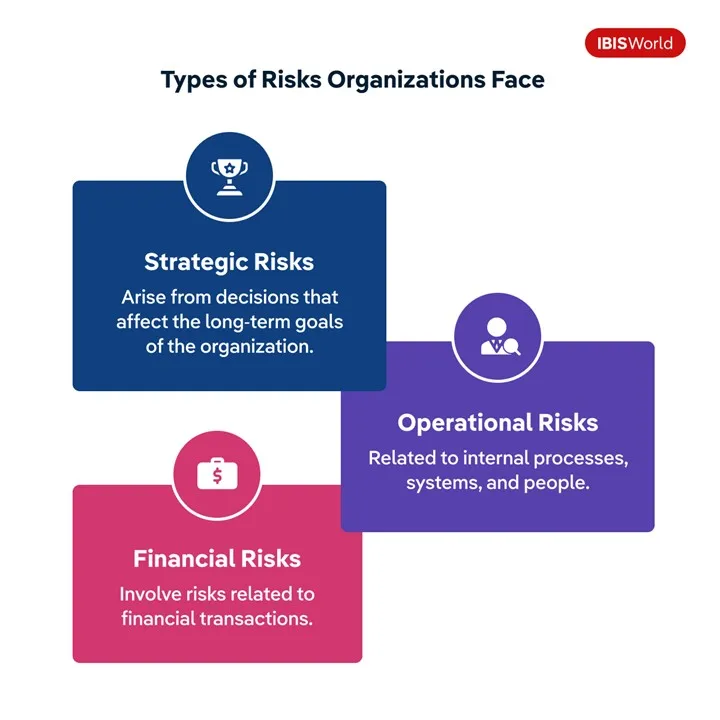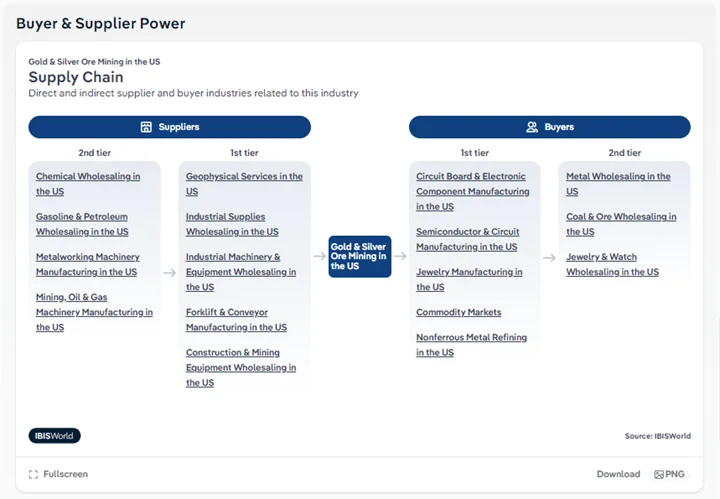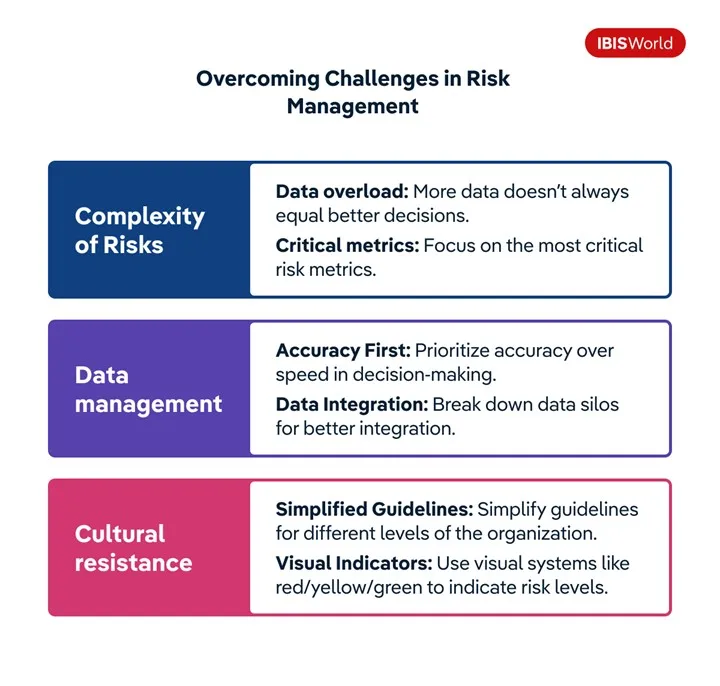
Jim Fuhrman
Commercial Banking Manager•United States
Jim leads IBISWorld’s Commercial Banking Client Service Division. Since 2017, he has worked strategically with banks & credit unions to achieve lending, underwriting, and credit risk initiatives.
August 29, 2024•11 min read
Key takeaways
Integrating risk management into strategic planning keeps businesses prepared for threats and ready to capitalize on opportunities.
Anticipating changes and adapting strategies are vital to navigating industry shifts effectively.
Industry research helps identify emerging risks, benchmark practices and inform better decision-making.
It’s funny – I’ve had the same close-knit group of friends for decades. Once a month, we gather for dinner in the city, catching up on life’s latest adventures, vacations, reliving the good old school days. Yet, despite all these years of friendship, I’d struggle to explain exactly what any of them do for work.
It’s a common paradox many can relate to, and it came up in our group chat recently. Since we already had another dinner planned, we decided to have some fun with it. The challenge? Everyone had to deliver their best elevator pitch about their job at our next meetup.
A few weeks later, our half-baked idea felt like the start of a bad joke – a salesman, a financier and an advertiser walk into a bar. But what surprised us all was how connected our professional worlds turned out to be. We discovered that we shared more customers and industry lingo than we ever imagined.
My friend in advertising, for example, works with a client in the gummy vitamin industry. As part of his media planning, he dug into the extreme seasonality reflected in the client’s sales and marketing spend.
The client identified three key factors that dictated the speed and timing at which their business could move and explained how their vigilance toward these risks allowed them to forecast more accurately and spend more prudently. It wasn’t just about managing day-to-day operations; it was about embedding risk management into their long-term strategic planning to align short-term actions with future goals.
With risk management woven into their strategic fabric, they pinpointed three critical factors that shape their business operations. Here’s how they tackled each one:
Ingredient seasonality
The ingredients for these vitamins face their seasonal challenges in producing the inputs, as certain plants only grow in warmer months. To navigate this, the client must order inventory in the harvest months and find ways to maintain inventory throughout the year.
Climate-related manufacturing risks
The next reason is also climate-related. Since these vitamins are manufactured in gummy form, warmer months in consumer markets pose a threat to customer experience as high temperatures will melt the gummies, rendering them an unappealing gummy glob. In these warmer consumer climates, it made more sense to stock shelves with capsules rather than gummies. To mitigate this risk, the client must think creatively about where and when to allocate marketing dollars to specific markets based on a formula of demand in variable climates.
Consumer motivation and seasonality
The client’s sales also hinge on consumer motivation to get healthy in the new year and sustain that lifestyle. This requires careful planning to balance inventory with market spend, ensuring they don’t overspend, overproduce or underdeliver, especially since the start of the new year is months away from the harvest.
After better understanding the risks that dictate performance for his customer, my friend immediately appreciated a new concept: risk management and mitigation. He realized that these insights weren’t just about managing risks; they were key to shaping a strategic plan that anticipates challenges and positions the company for long-term success.
Risk management: The cornerstone of effective strategic planning
As my friend’s experience with the gummy vitamin client shows, risk management isn’t just about avoiding pitfalls – it is the foundation upon which successful strategic planning is built. Risk management is a critical function for organizations across various industries, aiming to identify, assess and mitigate potential risks that could hinder the achievement of business objectives. As part of strategic planning, risk management ensures that businesses are prepared for potential threats and positioned to capitalize on opportunities that might be overlooked.
Effective risk management strategies have become paramount as industries evolve and the business landscape becomes increasingly complex. Managing risk is not only relevant during major world events, but is also extremely important to monitor seemingly mundane fluctuations in the macroeconomy.
But what kinds of risks should businesses be aware of and how can they be woven into strategic planning? Let’s break them down.

What types of risks do organizations face?
To integrate risk management effectively into strategic planning, it’s important to first recognize the various types of risks that organizations face. By categorizing these risks, businesses can better prepare for challenges and opportunities. Let’s take a closer look at the key categories that every strategic plan should consider:
Strategic risks
These arise from decisions that affect the organization’s long-term goals. For example, entering a new market or launching a new product carries inherent strategic risks.
Operational risks
These are related to the internal processes, systems and people within the organization. Examples include supply chain disruptions, system failures and human errors.
Financial risks
These involve risks related to financial transactions, including market risk, credit risk, liquidity risk and interest rate risk.
Understanding these different types of risks is the first step in effective risk management – a critical element of strategic planning. By recognizing and categorizing these risks, businesses can develop strategies to manage them effectively.

What are the three keys to strategic risk management?
Now that we’ve categorized the types of risks, let’s explore three key aspects of risk management that are essential for successful strategic planning:
Minimizing potential losses
By identifying and assessing risks, companies can take proactive measures to prevent them from materializing. In the context of strategic planning, this foresight allows businesses to develop contingency plans that protect their long-term objectives and ensure stability in the face of uncertainty.
Enhancing decision making
Effective risk management enhances decision-making processes. When organizations understand the risks associated with different strategies, they can make informed choices that balance potential rewards against potential downsides. This informed approach is at the heart of strategic planning, where each decision is carefully weighed to align with the company’s overall vision and goals.
Ensuring regulatory compliance
Regulatory compliance is a significant driver for risk management. Many industries are subject to stringent regulations that require solid risk management practices to ensure compliance and avoid legal penalties. Strategic planning must account for these regulatory requirements, integrating them into the plan to avoid costly setbacks and maintain a strong market position.
With these key principles in mind, let’s examine how they are applied in the real world through strategic planning.
Applying risk management to strategic planning
The most successful companies don’t just react to changes — they anticipate them. Here’s how this plays out.
While sales are generally the truest indicator of demand and product quality, the most successful products are those that prepare for headwinds and tailwinds long before they hit the market. Thoughtful planning has gone into the manufacturing, sales and distribution strategy of all the best-selling products you know. This level of foresight is a key component of effective strategic planning.
The reason is simple: top-performing companies always consider the macroeconomic headwinds and tailwinds their businesses may face to mitigate risks and capitalize on opportunities. On the flip side, think of Blockbuster & Kodak, which were leading the way in their respective industries but ultimately failed because they didn’t adapt their strategic plans to account for emerging trends. These companies rode the tailwinds of consumer demands for decades but failed to adapt to trends outside their control.
Netflix’s evolution
In contrast, Netflix offers a powerful example of a company that effectively integrated risk management into its strategic planning process, ultimately shaping it into the industry leader we recognize today. Originally a DVD rental service, Netflix identified the risk of becoming obsolete as consumer behaviors shifted. By transitioning to a streaming model, Netflix was able to avoid the fate of Blockbuster and emerge as a leader in the entertainment industry. This strategic pivot displays the importance of proper planning and risk management – illustrating that failing to plan is indeed a plan to fail.
Tying it all together
Maybe you began reading this with the concept of managing risks as a nebulous idea or maybe it had been explained in an overly technical way that scared you away from the topic. Through the anecdote and examples shared above, the concept of managing risk should now be more relatable. After all, we have all lived through these industrial oversights that resulted in business failures, or at least read about them as case studies at school.
These successful and unsuccessful examples highlight the often overlooked, yet crucial, aspect of risk management in strategic planning: the macroenvironment. To defend against the waves that are sure to come, businesses must scan the radar for potential threats and incorporate these insights into their strategic planning process. Because no matter how strong a boat you build, even the mighty Titanic was taken down by something that appeared insignificant on the surface.
As a business owner, investor, or creditor, the concept of risk management must be critically applied and monitored consistently within the framework of strategic planning to ensure readiness at the sight—or anticipated sight—of threats on the horizon.
This is where industry research comes into play. Businesses need reliable data and insights to scan the horizon and anticipate emerging risks. Industry research provides crucial information, helping organizations to stay informed and prepared. Let’s explore how it can support and strengthen your risk management strategies.
How to maximize risk management through industry research
Industry research is a powerful tool. It plays a critical role in developing risk management strategies. Organizations can make smarter decisions that align with their strategic goals by staying informed about emerging risks and industry trends.
But identifying risks is only the beginning. To manage risks effectively, businesses need to continuously monitor and adjust their strategies based on the latest industry research. This ongoing awareness allows companies to respond quickly to new threats and take advantage of emerging opportunities.
Here’s how industry research can be applied to risk management:
Identifying emerging risks
Industry research helps organizations stay abreast of emerging risks that could impact their operations. For instance, conflict in an oil producer’s country will have downstream impacts across multiple sectors as supply becomes limited. By identifying which industries rely heavily on oil prices, businesses can better understand and prepare for these impacts ahead of time.

Benchmarking best practices
Industry research enables organizations to benchmark their risk management practices against industry standards. This helps them identify gaps in their current practices and adopt best-in-class strategies. Understanding how your industry’s risks compare to others can guide you in refining your strategies and ensuring you’re following best practices.
Ongoing monitoring
Risk is never static and requires consistent checkpoints to ensure proper planning, forecasting and mitigation. Keeping a close watch on industry trends allows you to make necessary adjustments, ensuring you’re always prepared for what’s next.
Overcoming obstacles in risk management implementation
While industry research provides valuable insights and tools for managing risk, integrating these insights into strategic planning comes with its own set of challenges. Despite the benefits that research and data can bring and the advancements in risk management, organizations can face several challenges in putting these practices into action:
Complexity of risks
The increasing complexity of business operations and the interconnectedness of global markets make it challenging to identify and assess risks comprehensively.
Data management
Effective risk management relies on accurate and timely data. However, organizations often struggle with data silos, data quality issues and the sheer volume of data.
Cultural resistance
Embedding a risk management culture within an organization requires buy-in from all levels of the organization. Resistance to change can hinder the adoption of risk management practices.
Tips for overcoming these challenges
To navigate these challenges, here are a few practical strategies to keep in mind:
Focus on quality over quantity
More data doesn’t always equal better decisions. Be mindful of the risk metrics in your model, as a glut of data can dilute business-critical data.
Prioritize accuracy in data management
Prioritize accuracy over speed when making risk management decisions. Reliable, verified data should be the foundation of your strategic planning.
Simplify risk communication
Risk management guidelines should become progressively easier to digest as you work from back office to front. Risk management teams should be technical, but as these policies are communicated to front-line staff, consider a system of approvals to visually indicate risk levels and simplify decision-making. Color-coding can work for some teams, but others may find their own way of organizing.

The true cost of failing to plan
Risk management is indispensable across all sectors. By identifying, assessing and mitigating risks, organizations can protect their assets and enhance decision-making within their strategic planning processes.
Had Blockbuster considered the strategic, operational and financial risks of remaining in the Offline Video Rental industry, perhaps we’d have a blue and yellow streaming icon on our TVs today. Instead, they rode old coattails of success into the ground by failing to address the structural changes taking place around them as the industry evolved. Before long, profit shrank as revenues declined. Now, they’re a case study.
Industry research plays a pivotal role in advancing risk management practices by providing insights into emerging risks, best practices, and innovative strategies. However, it takes effort, planning and earnest monitoring to integrate these insights effectively into strategic plans. As the only constant is change, organizations must stay informed and adaptable to effectively manage risks and seize opportunities for growth.
In the end, failing to plan is planning to fail. By making risk management a fundamental part of strategic planning, businesses can better handle uncertainties and stay prepared for whatever comes next.
Source from IBISWorld
Disclaimer: The information set forth above is provided by ibisworld.com independently of Alibaba.com. Alibaba.com makes no representation and warranties as to the quality and reliability of the seller and products. Alibaba.com expressly disclaims any liability for breaches pertaining to the copyright of content.




